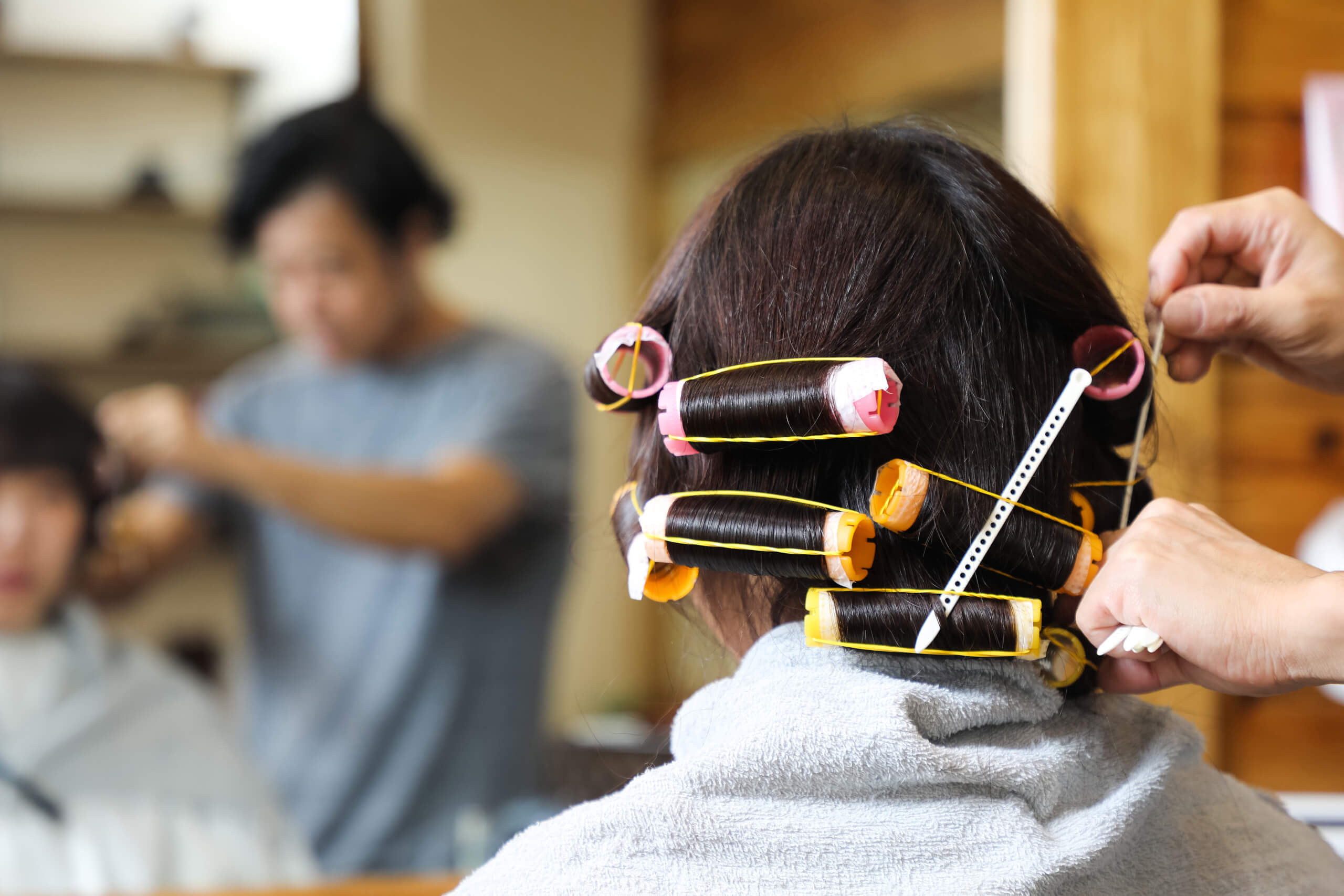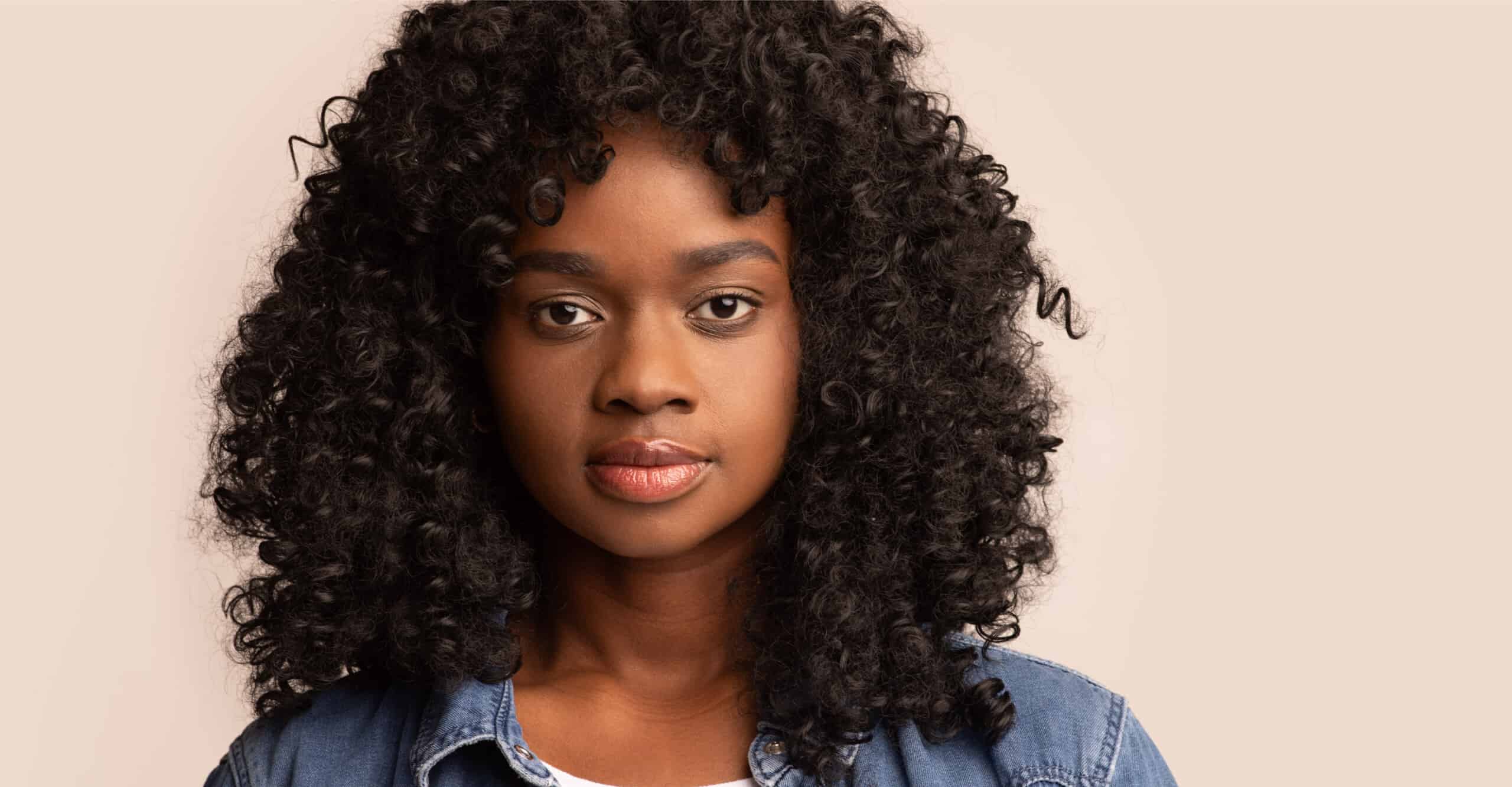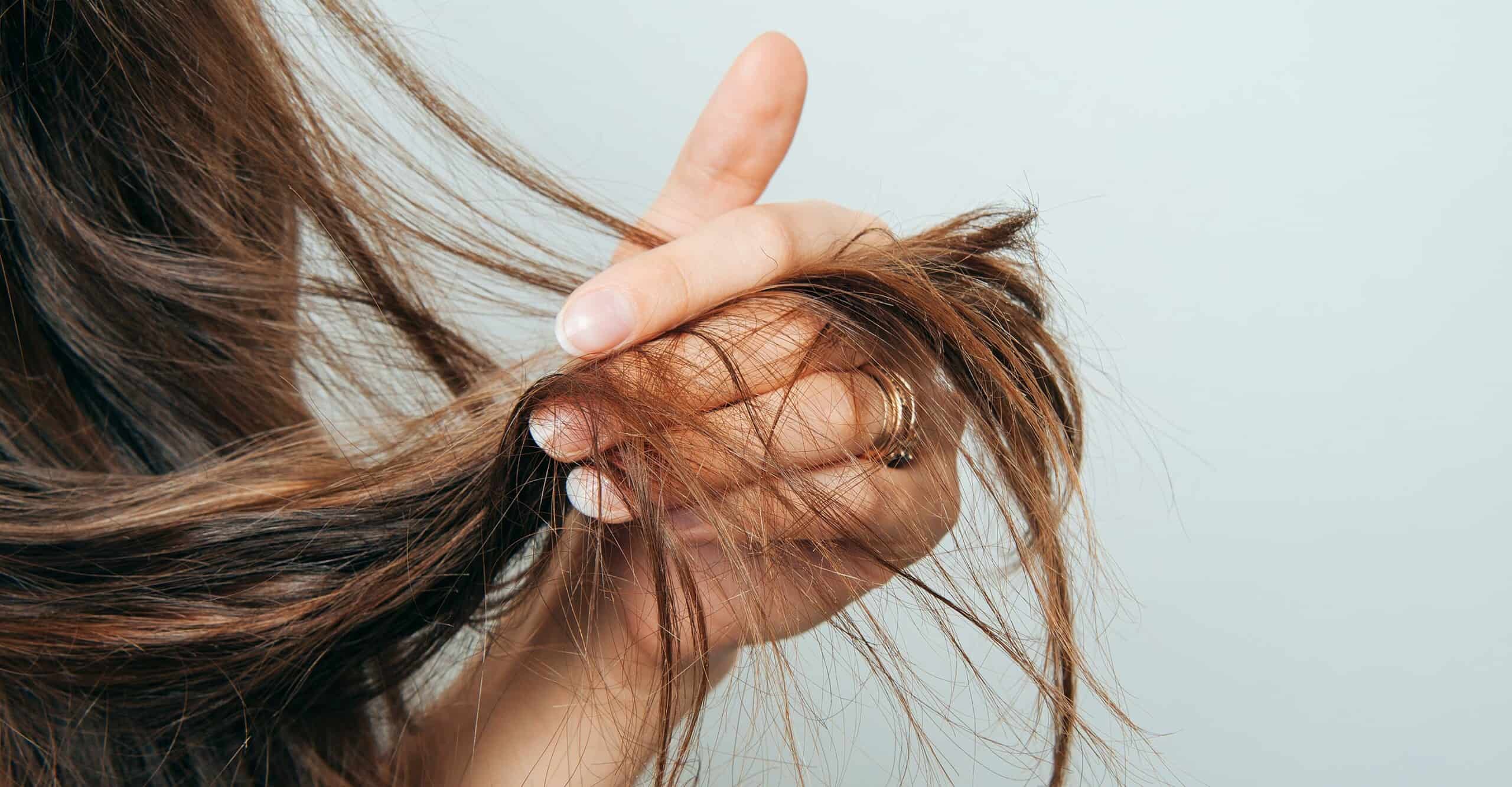11 Common Perm Rod Sizes & Curl Results

Perm rods are cylindrical plastic tools used to curl your hair. You can use them with or without chemical treatment. Choosing the right perm rod size depends on several factors, such as your hair texture, desired curl style and tightness, and hair length. With all these factors in mind, you can use this guide to ensure you choose the right size perm rods for your personal needs and desired style. If you’re considering a chemical perm, know that prices range from $30 to $800, depending on the factors outlined above. Stylists use chemical tools, including hot acid perms and cold alkaline perms, as well as other techniques to achieve the perfect style and texture.
Table of Contents
Perm Rod Sizes
Choosing the right perm rod size depends on how you want your curls to turn out. Since it can be difficult to identify the different perm rod sizes at a glance, they’re color-coded. For example, a ⅜ inch perm rod might be yellow and a 1¼ inch perm rod could be black. Color coding can vary by brand.
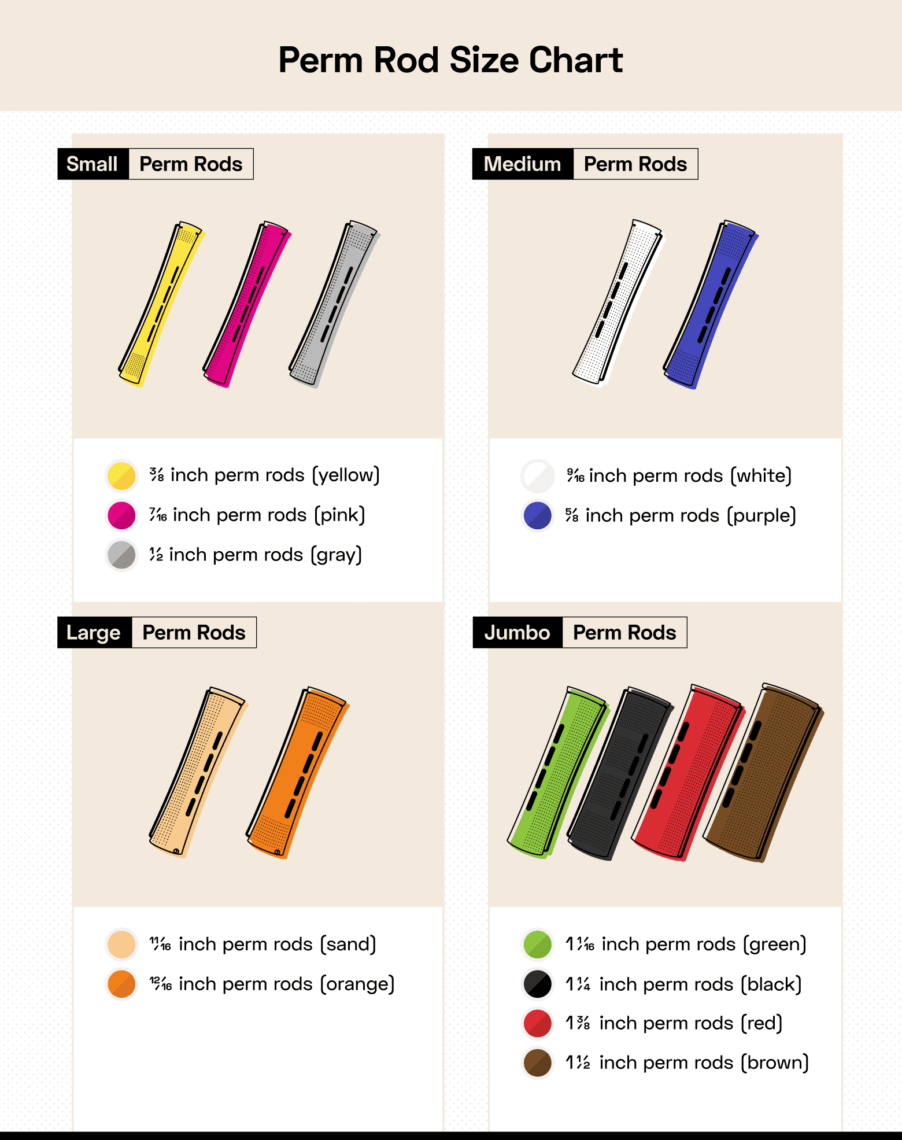
1. Small Perm Rods
Small perm rods have a diameter of a half-inch or less. The following rods produce tight curls and flowing ringlets:
- 3/8-inch perm rods: Use this size for the tightest corkscrew curls available.
- 7/16-inch perm rods: Great for very tight curl results, these rods can also create spiral curls on medium to long hair lengths.
- 1/2-inch perm rods: These rods are great for small, tight curls and can be used on hair of any length, depending on the desired curl.
2. Medium Perm Rods
Larger than small rods, these medium rods can still deliver tight curls:
- 9/16-inch perm rods: These rods deliver tight, bouncy curls. They create spiral perms for those with long hair.
- 5/8-inch perm rods: These rods create firm, springy curls for any hair length. Expect tighter curls than available from large rods.
3. Large Perm Rods
The following large perm rods create medium-sized curls and luscious waves.
- 11/16-inch perm rods: Ideal for medium-sized curls, this size rod produces voluminous curls for any hair length.
- 12/16-inch perm rods: Great for medium-tight curls on long and medium-length hair. People with short hair can achieve an excellent body wave from these rods.
4. Jumbo Perm Rods
These jumbo perm rods measure over 1 inch in diameter:
- 1 1/16-inch perm rods: This jumbo rod works great for creating bouncy, beachy curls in medium to long hair. They can also add body in shorter hair.
- 1 1/4-inch perm rods: Rods of this size can create true curls only in long hair. Otherwise, use it to add body to medium hair.
- 1 3/8 -inch perm rods: Too large for short hair, these rods add body to medium to long hair.
- 1 1/2-inch perm rods: The largest curl rod, use these only to add body.
Types of Perm Rods
In addition to different sizes, perm rods come in the following different types:
- Straight perm rods: Straight rods have the same diameter for the entire length of the rod. These create uniform curls and waves.
- Concave perm rods: The most commonly used perm rods, concave perm rods measure thinner in the middle and thicker at the ends. Use these rods to create curls of varying tightness.
- Flexi-rods: As the name says, flexi-rods have flexibility so you can wrap your hair around them as well as flex the rod into shapes, which adds even more texture and body to your hair. They come in various diameters like other rods, allowing loose waves or tight ringlets. Use them at home to achieve a variety of curl results.
Concave Perm Rods vs. Straight Perm Rods
Choosing between concave or straight perm rods depends on the look you want to achieve. When choosing, consider these differences:
- Concave rods, the most commonly used rods, produce curls that are tighter at the center but looser near the ends. Because of its concave shape, these rods can sit closer to your head and produce curls of varying thicknesses.
- Straight rods have the same thickness end to end and create uniform curls. These rods can’t be rolled close to your head, especially with longer hair, and make a great choice when wanting body waves.
Types of Perm Rod Materials
Just as perm rods come in different shapes and sizes, they come in the following materials, each with its own benefits:
- Plastic perm rods: The most common type of perm rod, you can easily clean and disinfect plastic perm rods.
- Wooden perm rods: For those wanting to reduce plastic use, wooden rods make a good choice, although they make cleaning and disinfecting a bit more difficult. Their smooth, wooden surface can also make it more difficult to keep hair rolled onto them.
- Self-fastening perm rods: Covered in tiny teeth, these plastic rods cling to your hair like a hook-and-loop closure, making it easier to roll on hair while keeping the rollers in place. Note: These rollers aren’t used in chemical perms.
How Many Perm Rods Do I Need?
Determining how many perm rods to use depends on the desired outcome and the length of your hair. Tighter curls need more rods than perms with looser curls or waves, and people with longer hair need more rods than people with shorter hair.
Match your hair and style to this list to get an idea of how many rods you need:
- Tight curls: For tight curls, like 2C hair, in long hair, expect to use close to 50 small-sized rods. People with short and medium hair will use between 20 and 40 rods to achieve tight curls.
- Loose curls: If you have long hair, you will use about 30 medium rods or just 20 large rods for a more beachy wave. Short and medium hair lengths will need approximately 24 medium rods for loose curl patterns or 10 to 15 large rods for waves.
Always keep in mind: the more rods, layers, or styles, the higher the cost of the perm.
What Is the Most Commonly Used Perm Rod?
Concave rods are the most commonly used rod. They create many types of curls and waves. Their smaller center diameter keeps the curl varied and close to the head.
How to Choose What Size Perm Rod to Use
Choosing a perm rod size depends on many factors, including your hair texture and length as well as the finished hairstyle you want.
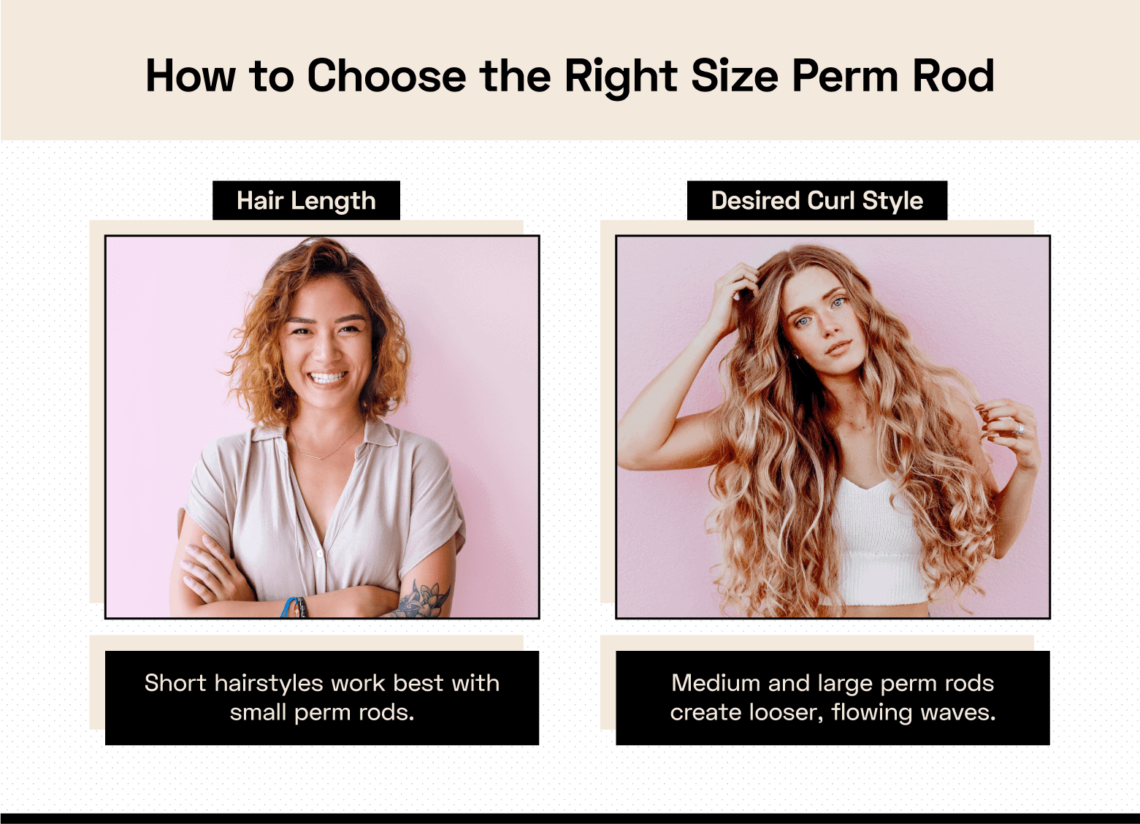
Hair Texture
When it comes to perms, hair texture matters. Your hair’s texture affects the processing agent, like using chemicals or heat, more than it affects which rod you choose. Perm rods have been designed with all hair textures in mind. So this list gives you an idea of how your hair texture can play a role in the perming process:
- Straight hair has little to no natural curl or wave. Straight hair can easily take any shape and style of perm, but the hair may be more willing to slip out of place during roller setting.
- Wavy hair doesn’t look exactly curly, but not straight either. Wavy hair benefits from rods that increase the volume of the existing waves.
- Curly hair can have several different shapes and sizes, and perm rod choices will be just as varied. Often, curly hair gets permed near the roots to help add more body.
- Tightly curled hair requires delicate care when perming. Often the most fragile, this hair type can break easily. Talk with your stylist to achieve the preferred look.
- Natural hair is already full of beautiful life and shape. As such, perm rods should accentuate the existing shape and style. Natural hair can also use perm rods without heat, using conditioners and hair masks to lock in the desired shape.
Hair Length
The more hair you have, the more you have to work with, but even shorter hair lengths can achieve bouncy curls and great volume with perm rods.
- Short hair: Short hair will need the smallest rods to achieve tight curls. Shorter hair will also need fewer rods.
- Medium length hair: Medium hair can achieve tight rings or loose waves by using the proper perm rods. Smaller rods will give tighter curls and body, and larger rods will create loose curls and waviness.
- Long hair: Long hair can use any type of perm rod. The more hair, the more times it can be wrapped to create the greatest variety of styles and curls.
Desired Curl Type
Although the best rod for your desired curl type depends on your hair texture and length, just remember that the smaller the perm rod, the tighter the curl. For instance, pin curl perms use smaller rods to achieve that natural springiness. Likewise, a beachy wave style will use larger rods for those lazy spirals. Your hair length further narrows your choices as shorter hair needs smaller perm rods than longer hair for many curl types.
Types of Perm Styles
Use perm rods to achieve these several different types of perms:
- Spiral Perm: One of the most common perms, it features tight ringlets from long perm rods. The final size of the spiral determines the size of the perm rod.
- Body Wave Perm: If you want to add body to naturally straight hair, using large rods on medium to long hair will produce loose waves that are perfect for volumizing.
- Spot Perm: Used to perm one or specific areas of the hair, these perms can be of nearly any style, but they use short rods to keep the perm confined to one place.
- Root Perm: Great for shorter hair, root perms add volume near the scalp. This perm can help give body to hair of any texture and length.
- Pin Curl Perm: Smaller rods create tight ringlets in this perm that best suits long hair.
- Multi-Textured Perm: This style uses two rod sizes throughout the hair to create a naturally varied style.
- Beach Wave Perm: Create loose waves by using large rods in long hair.
- Straight Perm: Also known as a reverse perm, this takes the existing curl out of your hair. This doesn’t use perm rods, but it does involve the same alkaline chemicals, as well as hot irons for straightening.
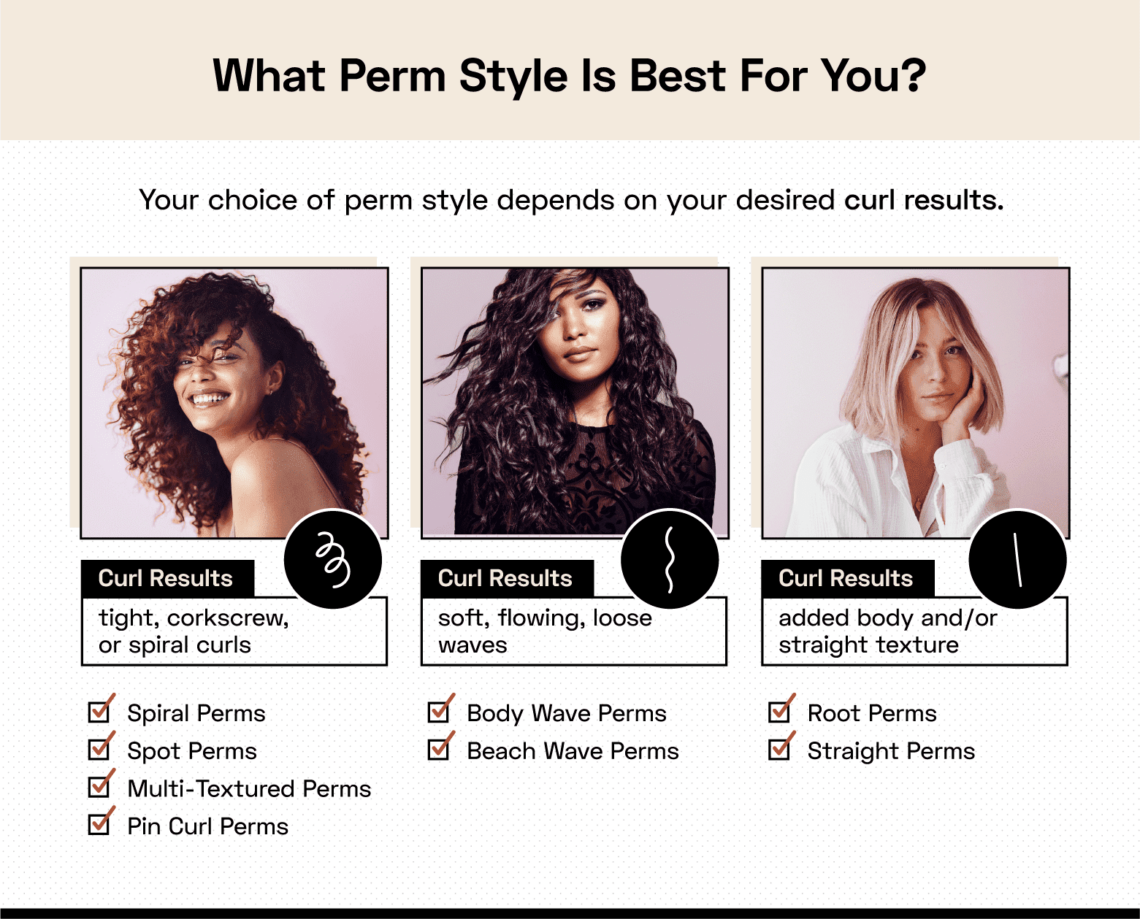
How to Use Perm Rods
You can create a perm using this four-step process:
- Start with clean, damp, untangled hair and add your favorite mousse or oil, if desired.
- Divide your hair into sections and wrap locks around your chosen rods. Begin at the bottom of each lock, and roll up to the roots.
- If not using any chemicals, simply wait for your hair to dry before removing the rods. This won’t lock in the curls, but it will keep them set for a day.
- If using chemical perm solutions, apply them to each rolled lock and allow it to sit for up to 15 minutes. When done, rinse with the rods in, apply the neutralizer, rinse again, and dry for your curls!
How to Care for A Perm
Maintaining a perm requires specific products and hair care. You shouldn’t wash your hair during the first 48 hours after a perm, and when it is time to wash, use shampoos and conditioners specifically formulated for perms. Be sure to use conditioner regularly to ensure your hair regains its natural strength.
Avoid washing and drying with high heat to keep your curls for longer. Only use hair products that are free from dyes, sulfates, or alcohol since these chemicals will dry out and damage your hair. Wrapping your locks up at night in a silk scarf can help protect them from frizz and damage.
Nearly every hair type can showcase wonderful curl results after using perm rods. From tight ringlets to carefree waves, achieving your desired style starts with choosing the right perm rod. Keeping in mind that the tighter the curl, the smaller the rod, you can change up your look with on-trend curls that fit your personality and style.If you’re ready to add bounce and waves to your hair, use StyleSeat to look for and book an appointment with the perfect stylist.
